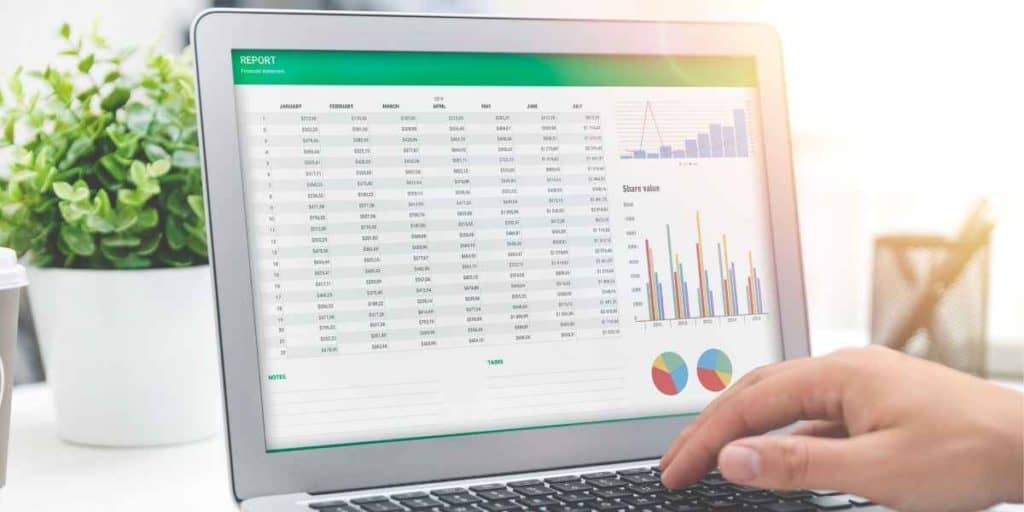Data scientists use all sorts of programs to research, compile, and compare the information. Without the proper tools, they wouldn’t be able to perform their jobs half as well as they currently do. Microsoft Excel is a popular document tool that allows people to do all sorts of tasks, but is it popular among data scientists?
Data scientists use Excel if they receive information via an Excel document. They typically use other programs, such as Python or R, but Excel has perks that make it a contender for many people. Furthermore, the learning curve for Excel is much less than most other programs used by data scientists.
Throughout this article, you’ll also learn the following information about when and why data scientists use Microsoft Excel:
- Different tools and functions that are used on Excel
- Reasons why it is and isn’t a good tool
- Other programs used by data scientists to compile data
Important Sidenote: We interviewed numerous data science professionals (data scientists, hiring managers, recruiters – you name it) and identified 6 proven steps to follow for becoming a data scientist. Read my article: ‘6 Proven Steps To Becoming a Data Scientist [Complete Guide] for in-depth findings and recommendations! – This is perhaps the most comprehensive article on the subject you will find on the internet!
Table of Contents
What Can a Data Scientist Use Excel For?
Microsoft Excel is used for all sorts of different tasks. Data scientists operate with a variety of programs, and Excel isn’t always at the top of the list. However, you might be surprised to learn about the simplicity and ease of access that makes many data scientists reach for the program during tough times.

Here’s a list of reasons why a data scientist might use Excel:
- Data scientists can take advantage of conditional formatting tools in Excel. Conditional formatting allows the user to visualize the data by changing the appearance of cells based on the specified condition and makes it easier to analyze and understand the data.
- Pivot Tables are one of the most powerful features of Microsoft Excel to be used by a Data Scientist. Data can be easily summarized using Pivot Tables. With just a few clicks, you may have access to the summary (comparisons, patterns, trends, etc.) of thousands and thousands of cells.
- Microsoft Excel is debatably the easiest data tool to learn in the industry. Unlike other databases, Excel can be learned in a matter of minutes. You can spend less than an hour and gather more information about Excel than you could about any other program used by a data scientist.
- Excel is also incredibly inexpensive. If you buy it in the Microsoft Office bundle, you’ll also have access to Powerpoint, Word, and many other popular programs. You never know when you might need to use them for work, school, or personal situations. If you’re a new data scientist on a budget, then Excel should be on your list.
- It comes with a plethora of preset templates. You already know what you’re trying to create, but having access to these templates can shave minutes or hours off of your workload. You’ll be able to spend more time compiling data, transferring information to clients, and focusing on the task at hand.
- You can set labels on Excel that correspond and interact with every other cell with the same label. If you want to make a specific set of conditions for multiple cells that aren’t related, you can code the label, hit Enter, and watch as everything falls into place. This simple tool can save time, headaches, and money, in some cases.
If you’re convinced that Excel is a good tool for data scientists, then you’re right! There are dozens of other tools and reasons that aren’t listed as well. However, there’s always going to be ups and downs when it comes to different programs. In the next section, we’ll cover everything you need to know.
Pros and Cons of Excel
Microsoft Excel is far from the most advanced, technical program for data scientists. That being said, it shouldn’t be left to gather dust. Let’s check out all of the positive and negative reasons for Excel and data science below.
Pros of Microsoft Excel for Data Scientists
Listed below are the primary advantages of using Excel as a Data Scientist:
- As you read in the previous section, there are plenty of tools for data scientists to take advantage of Excel. It offers column specifications, visual basics, templates, and a variety of other possibilities. Having it downloaded can save you countless hours over the years of being a data scientist.
- Medium points out that Excel makes data mapping much easier. You don’t need to be an advanced professional to map on Excel. It takes most of the hard work out of the task, leaving you with the basics. You’ll be able to focus on exact data rather than trying to figure out how to run the program.
- Excel doesn’t take up a lot of data. If you’re working from a laptop or desktop computer without much storage space, Excel won’t overload the system. Many other programs are labor-intensive, requiring two to three times the amount of gigabytes of storage. It also doesn’t take much memory to run.
- It’s an incredibly simple program for beginners. If you’re just breaking into the career, you might feel overwhelmed with the info needed to run the major programs. Starting with Excel can get you through the beginner phase, allowing you to understand the gist of the topic before getting a better program.
- Finally, Excel has been around for quite some time and Microsoft continues to implement updates. Even if you don’t use it too often, it’s worth having the program as a backup. There are always new tools to try out, many of which become an integral part of your career as a data scientist.
Cons of Microsoft Excel for Data Scientists
Listed below are the primary disadvantages of using Excel as a Data Scientist:
- Excel is limited in the sense that it doesn’t quite compare to the big names in the industry. Many high-end data scientists would probably laugh at the idea of using Excel for their clients. It lacks the tools and quality that Python, R, and other data science tools are already equipped with.
- Most big businesses don’t use Excel documents, which means you won’t be able to submit the proper format. When you upload an Excel doc to one of these businesses, they can’t access it. You’ll have to transfer the data or redo the entire project, both of which are unnecessarily time-consuming.
- Excel cannot be used for a larger set of data. Excel has a limit of 1,048,576 rows and 16,384 columns. So, if you are dealing with data sets containing millions of cells, excel is not an option in that case.
What Other Programs Do They Use to Compile Data?
Although Excel is useful, you’ll more than likely end up using a variety of other programs as a data scientist. You’ve already heard of two of the programs in this article; R and Python. Let’s break them down below:
- According to R-Project, R is an online data language that can be used in a wide range of projects to collect data and store it. It’s one of the most common data science tools, which is why it’s highly recommended across the board. Currently, it’s free software that almost anyone can use.
- Python explains itself as a high-end data language that’s used for general purpose applications. Many users find that it’s easier to learn and slightly better quality than other data analysis programs. Much like R, Python is currently a free program.

The advantage that Excel has over both of these programs is that it’s easy to read. Note that some companies prefer Excel due to its simplicity, but there’s no denying the fact that you’ll have to learn how to use Python and R eventually.
Author’s Recommendations: Top Data Science Resources To Consider
Before concluding this article, I wanted to share few top data science resources that I have personally vetted for you. I am confident that you can greatly benefit in your data science journey by considering one or more of these resources.
- DataCamp: If you are a beginner focused towards building the foundational skills in data science, there is no better platform than DataCamp. Under one membership umbrella, DataCamp gives you access to 335+ data science courses. There is absolutely no other platform that comes anywhere close to this. Hence, if building foundational data science skills is your goal: Click Here to Sign Up For DataCamp Today!
- IBM Data Science Professional Certificate: If you are looking for a data science credential that has strong industry recognition but does not involve too heavy of an effort: Click Here To Enroll Into The IBM Data Science Professional Certificate Program Today! (To learn more: Check out my full review of this certificate program here)
- MITx MicroMasters Program in Data Science: If you are at a more advanced stage in your data science journey and looking to take your skills to the next level, there is no Non-Degree program better than MIT MicroMasters. Click Here To Enroll Into The MIT MicroMasters Program Today! (To learn more: Check out my full review of the MIT MicroMasters program here)
- Roadmap To Becoming a Data Scientist: If you have decided to become a data science professional but not fully sure how to get started: read my article – 6 Proven Ways To Becoming a Data Scientist. In this article, I share my findings from interviewing 100+ data science professionals at top companies (including – Google, Meta, Amazon, etc.) and give you a full roadmap to becoming a data scientist.
Conclusion
Microsoft Excel is definitely a useful tool in the data science industry. It might not be at the top of the data charts, but it’s worth the time and investment. Learning how to use Excel can help beginners get into the motion of collecting, analyzing, and reporting information to clients or for their business.
Here’s a quick recap of the post:
- Excel, Python, and R are all popular data science tools.
- Excel is cheap and easy to use.
- There are plenty of preset templates and customizable cells in Excel.
- Eventually, you’ll have to learn how to use other advanced data science programs.
BEFORE YOU GO: Don’t forget to check out my latest article – 6 Proven Steps To Becoming a Data Scientist [Complete Guide]. We interviewed numerous data science professionals (data scientists, hiring managers, recruiters – you name it) and created this comprehensive guide to help you land that perfect data science job.
Affiliate Disclosure: We participate in several affiliate programs and may be compensated if you make a purchase using our referral link, at no additional cost to you. You can, however, trust the integrity of our recommendation. Affiliate programs exist even for products that we are not recommending. We only choose to recommend you the products that we actually believe in.
Recent Posts
Data science has been a buzzword in recent years, and with the rapid advancements in artificial intelligence (AI) technologies, many wonder if data science as a field will be replaced by AI. As you...
In the world of technology, there's always something new and exciting grabbing our attention. Data science and analytics, in particular, have exploded onto the scene, with many professionals flocking...
